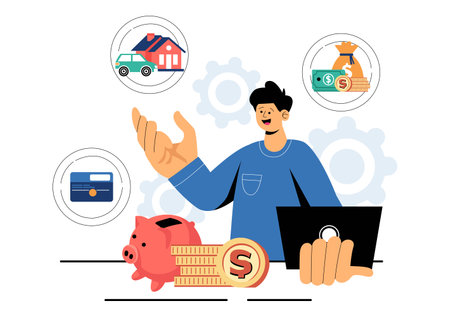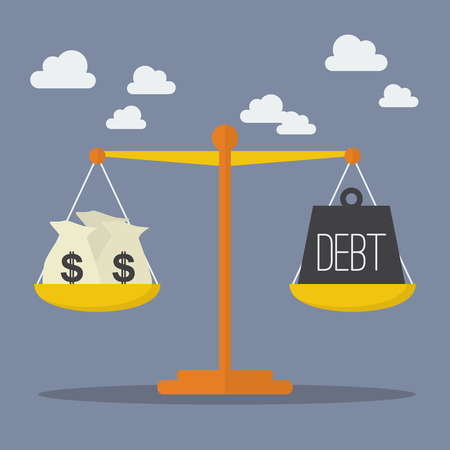Understanding Debt Consolidation Loans
If you’re struggling to keep up with multiple debts, a debt consolidation loan might be the solution you need. In the United States, many people use debt consolidation loans to simplify their monthly payments and potentially lower their interest rates. Let’s break down what these loans are, how they work, and why they could help you manage your finances more effectively.
What Is a Debt Consolidation Loan?
A debt consolidation loan is a type of personal loan you use to pay off several existing debts. After getting approved for this loan, you use the funds to pay off credit cards, medical bills, or other types of unsecured debts. This leaves you with just one monthly payment instead of several.
How Does It Work?
The process is straightforward:
| Step | Description |
|---|---|
| 1. Apply for a Loan | You choose a lender and apply for a debt consolidation loan. |
| 2. Receive Funds | If approved, you get the loan amount as a lump sum. |
| 3. Pay Off Debts | You use the funds to pay off your existing debts in full. |
| 4. Make One Payment | You now make one monthly payment to your new lender until the loan is paid off. |
Why Consider Debt Consolidation?
Here are some reasons Americans choose debt consolidation loans:
- Simplified Payments: Combining all your debts into one means fewer due dates and less hassle.
- Potentially Lower Interest Rates: If your credit score has improved or if your current debts have high interest rates (like credit cards), a debt consolidation loan can save you money over time.
- Improved Credit Score: Making on-time payments on your new loan may help boost your credit score over time.
- Less Stress: Managing one payment each month is often less stressful than juggling multiple bills.
Debt consolidation loans aren’t right for everyone, but understanding how they work is an important first step toward taking control of your finances in the US.
2. Checking Your Credit and Financial Status
Why Your Credit Score Matters
Before applying for a debt consolidation loan in the US, it’s important to know your credit score. Lenders use your credit score as a quick way to judge how risky it is to lend you money. A higher score usually means you’ll get better interest rates and more options. If your score is low, you may still qualify, but the rates could be higher.
Credit Score Ranges
| Credit Score Range | Rating | What It Means |
|---|---|---|
| 800 – 850 | Excellent | Best rates and terms available |
| 740 – 799 | Very Good | Great approval odds and good rates |
| 670 – 739 | Good | Qualifies for most loans, decent rates |
| 580 – 669 | Fair | Higher rates, fewer options |
| 300 – 579 | Poor | Difficult to qualify, high rates likely |
Reviewing Your Financial Situation
Lenders will look at more than just your credit score. They want to see if you have a steady income, what your monthly expenses are, and how much debt you already owe. This helps them decide if you can handle another loan payment. Be honest with yourself about your finances so you know what you can really afford.
Key Things Lenders Check:
- Income: Is your income stable? Can you show pay stubs or tax returns?
- Debt-to-Income Ratio (DTI): This is how much of your monthly income goes toward paying debts. Most lenders like to see a DTI below 40%.
- Total Debt: How much do you owe on credit cards, auto loans, student loans, etc.?
- Savings: Do you have any savings in case of emergency?
- Your Payment History: Have you missed any payments recently?
How to Find Out Where You Stand
- Check Your Credit Report: You can get a free report each year from AnnualCreditReport.com.
- Add Up Your Debts: Make a list of all your current debts and minimum monthly payments.
- Create a Budget: Write down your income and expenses so you know what’s left over each month.
- Calculate Your DTI:
| Total Monthly Debt Payments ($) | ÷ | Total Gross Monthly Income ($) | = | Your DTI (%) |
|---|
If your DTI is too high, consider paying off some smaller debts before applying for a debt consolidation loan.
Lender Perspective: Why These Factors Matter in the US
Banks and credit unions in the US follow strict guidelines when lending money. They use your credit score and financial status to predict whether youll make payments on time. This protects both them and you from getting into a loan that’s hard to pay back. By checking these things first, youll be more prepared — and more likely to get approved with good terms.

3. Researching and Comparing Lenders
How to Find Reputable US-Based Lenders
Start by looking for lenders that are licensed to operate in your state and have a solid reputation. You can check reviews on trusted websites like the Better Business Bureau (BBB), Consumer Financial Protection Bureau (CFPB), or Trustpilot. Local credit unions, well-known banks, and reputable online lenders are often good starting points.
Key Signs of a Trustworthy Lender:
- Clear contact information and a physical address in the US
- Transparent loan terms with no hidden fees
- Positive customer reviews and ratings
- No pressure tactics or upfront fees before approval
Understanding Loan Terms and Offers
When comparing debt consolidation loans, pay attention to the following terms:
| Loan Term | What It Means | Why It Matters |
|---|---|---|
| APR (Annual Percentage Rate) | The yearly interest rate including fees | A lower APR means less paid over the life of the loan |
| Loan Amount | The total money you can borrow | Should cover your existing debts without being excessive |
| Monthly Payment | Your required payment each month | Must fit comfortably into your budget |
| Repayment Term | The time you have to pay back the loan (e.g., 36 or 60 months) | A longer term lowers payments but increases total interest paid |
| Fees | Origination, late, prepayment penalties, etc. | Can add up—look for low or no-fee options |
Comparing Rates from Different Lenders
Shop around! Request quotes from multiple lenders—these are often called “pre-qualification” offers and usually do not affect your credit score. Compare APRs, monthly payments, fees, and any perks like autopay discounts. Use online calculators to estimate your savings.
Lender Comparison Example:
| Lender Name | APR Range | Fees | Minimum Credit Score Required |
|---|---|---|---|
| Main Street Bank | 7% – 15% | No origination fee; $25 late fee | 660 |
| Online Direct Lender A | 6.5% – 19% | $100 origination fee; $0 late fee first time | 640 |
| Your Local Credit Union | 5% – 14% | No fees if auto-pay is set up; $20 late fee otherwise | 620 (members only) |
Avoiding Predatory Lending Practices
Pitfalls to watch out for include extremely high interest rates, aggressive sales tactics, requests for upfront payments before approval, and unclear terms. If something feels off or you’re pressured to sign right away, take a step back. Always read the fine print and never share sensitive personal information with unverified sources.
4. Gathering Required Documentation
Before you can apply for a debt consolidation loan in the US, you’ll need to collect several important documents. Lenders want to see proof that you can pay back the loan and get a clear picture of your current debts. To make the process smoother, have these standard documents ready ahead of time.
What Documents Will You Need?
The exact paperwork may vary depending on your lender, but here are the most common requirements:
| Document | Purpose | Examples |
|---|---|---|
| Proof of Income | Shows you have steady money coming in to repay the loan | Recent pay stubs, W-2 forms, tax returns, Social Security statements |
| Debt Statements | Details of the debts you want to consolidate | Credit card statements, personal loan statements, medical bills |
| Identification | Confirms your identity for security and legal reasons | Driver’s license, state ID card, passport |
| Bank Statements | Provides an overview of your financial habits and reserves | Checking and savings account statements from the last 2–3 months |
| Proof of Address | Verifies where you live in the US | Utility bill, lease agreement, mortgage statement |
Tips for Organizing Your Paperwork
- Create a checklist: Use the table above as your guide so you don’t miss anything.
- Scan copies: Many lenders accept digital uploads. Scanning your documents makes it easy to submit them online.
- Check document dates: Make sure everything is up-to-date—most lenders want recent records (within the last 60–90 days).
- Keep originals handy: You might need to show original copies at some point in the application process.
If You’re Self-Employed or Have Non-Traditional Income…
Lenders may ask for extra documentation like recent tax returns (usually two years), bank statements showing deposits, or 1099 forms. It’s important to be thorough so there’s no delay with your application.
5. Applying for the Loan and Managing the Process
Step-by-Step Application Process
Once you’ve chosen a lender and prepared your documents, it’s time to apply for your debt consolidation loan. Here’s what you can expect:
| Step | What to Do | Tips |
|---|---|---|
| 1. Complete the Application | Fill out the lender’s online or in-person application form with accurate personal and financial details. | Double-check all information for accuracy to avoid delays. |
| 2. Submit Documentation | Upload or provide required documents such as proof of income, identification, and statements of debts. | Keep digital copies handy for quick access. |
| 3. Wait for Approval | The lender will review your application and may contact you for additional information. | Respond promptly to any requests to speed up the process. |
| 4. Review Loan Offer | If approved, carefully review the loan terms, interest rates, fees, and repayment schedule. | Ask questions if anything is unclear before accepting the offer. |
| 5. Accept the Loan | Sign the agreement electronically or in person to finalize your loan. | Make sure you understand your obligations before signing. |
What Happens After You Apply?
After submitting your application, most lenders will give you a decision within a few days. If you’re approved, funds are usually sent directly to your existing creditors or deposited into your bank account so you can pay off your debts yourself. Make sure to confirm that your old balances are fully paid off and keep records for future reference.
If Your Application Is Denied
If you don’t get approved, don’t get discouraged. Ask the lender why your application was denied—common reasons include low credit scores or high debt-to-income ratios. Use this feedback to improve your financial profile before applying again.
Managing Your Debt Consolidation Loan
Create a Repayment Plan
Set up reminders or automatic payments so you never miss a due date. Most lenders offer autopay options that can help streamline this process and sometimes even lower your interest rate slightly.
Track Your Progress
Monitor your monthly payments and outstanding balance using online banking tools or budgeting apps. This helps keep you motivated as you watch your debt shrink over time.
Helpful Tips for Staying on Track:
- Avoid taking on new debt: Focus on paying off your consolidation loan before using credit cards again.
- Create an emergency fund: This helps prevent future borrowing if unexpected expenses pop up.
- Review your budget regularly: Adjust as needed to ensure you stay financially stable while repaying your loan.
- Contact your lender early if issues arise: If you’re struggling with payments, many lenders are willing to work with you if you reach out before missing a payment.
The application process might seem intimidating at first, but breaking it down step by step makes it much more manageable. By understanding what to expect and how to manage your new loan responsibly, you’ll be well on your way toward greater financial stability.


